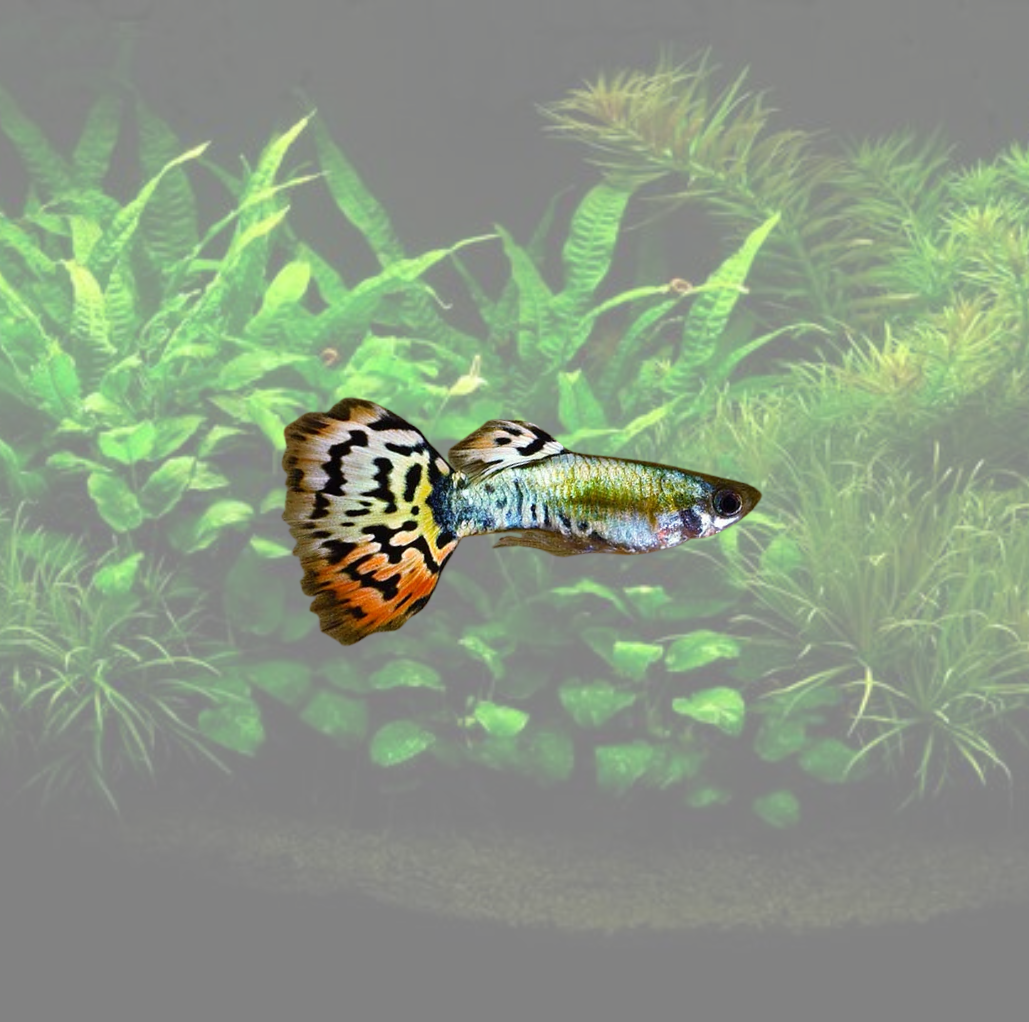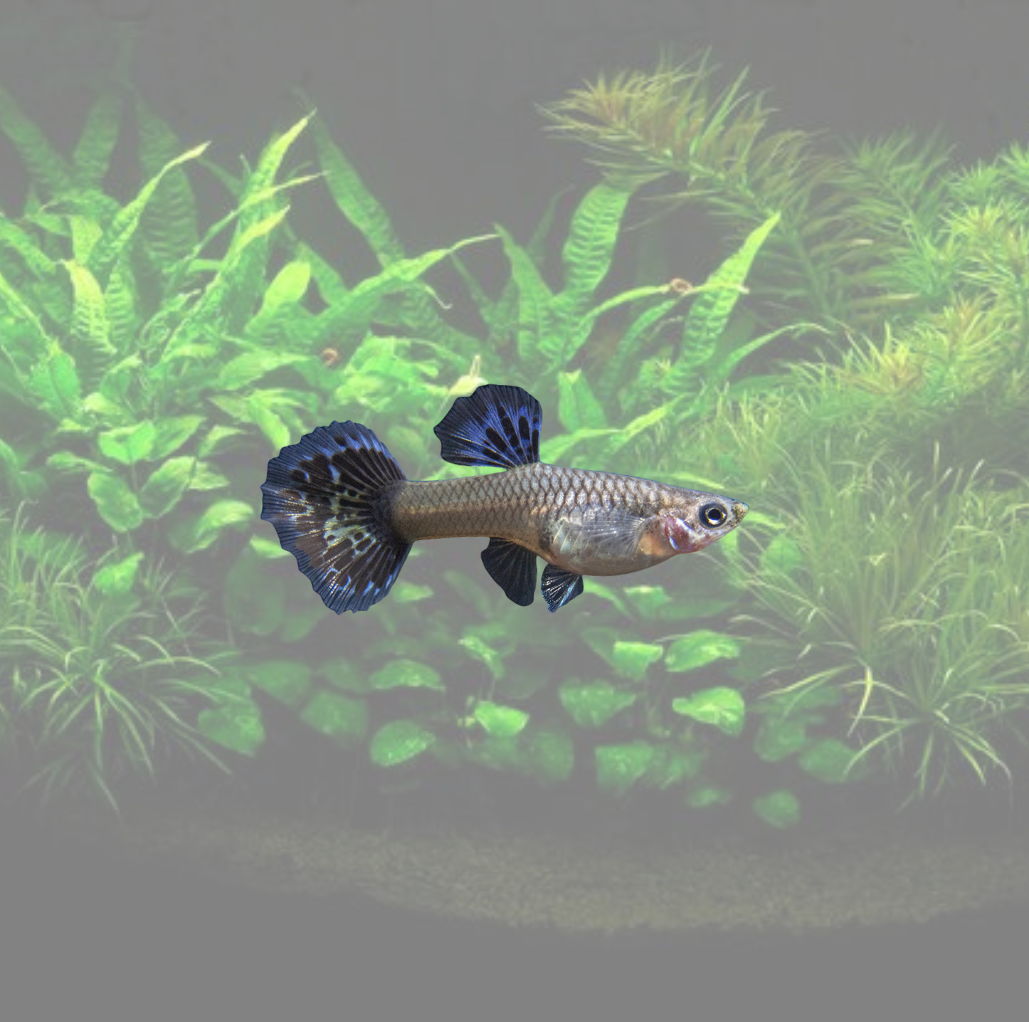Poecilia reticulata
Guppy

Scientific Classification
Quick Stats
Aquarium Building Information
About This Species
Basic Description
Detailed Description
Originating from the freshwater streams and rivers of South America, the Guppy is a species prized for its resilience and dynamic behavior. In their natural habitat, they inhabit waters with low-flow currents, warm tropical temperatures, and a wide spectrum of mineral content, which contributes to their remarkable adaptability in captivity. They can even tolerate slightly brackish conditions, a testament to their hardiness. For the discerning hobbyist, replicating this environment involves a well-filtered aquarium with gentle water movement and stable, warm water. As a shoaling species, they exhibit their most natural and confident behaviors when kept in groups; a solitary individual is prone to stress. A group dynamic allows for the observation of their intricate social interactions.
Physiologically, this fish possesses a high metabolic rate, fueling its constantly active lifestyle. This high energy level dictates a specific feeding regimen; multiple small feedings throughout the day are preferable to one large meal. A varied, omnivorous diet is crucial for their health and vitality. While high-quality flake or pellet food can serve as a staple, their diet should be supplemented with vegetable matter and protein-rich foods such as frozen or live offerings. This variety not only ensures balanced nutrition but also encourages foraging behavior. Their activity is concentrated in the top and middle strata of the water column, making them a highly visible and engaging species. When considering tank mates, their small size and characteristically long fins in males make them vulnerable to larger, aggressive, or fin-nipping fish. Ideal companions are other small, peaceful species that share similar water parameter requirements. Despite their hardiness, they produce a moderate amount of waste relative to their size, necessitating regular water changes to maintain a low-nitrate environment and ensure they live out their full, albeit relatively short, lifespan.
Scientific Description
Poecilia reticulata is a small, freshwater fish belonging to the family Poeciliidae, a family distinguished by its livebearing reproductive strategy. Native to various drainage systems in northeastern South America, its ecological success is largely due to its exceptional adaptability. The species exhibits a fusiform body shape, an evolutionary trait optimized for maneuverability and sustained swimming in low-flow aquatic environments. Pronounced sexual dimorphism is a key characteristic; males are typically smaller and exhibit extensive chromatic and morphological variation, including ornate finnage, while females are larger, more robust, and less colorful.
This species demonstrates a wide tolerance for a range of physicochemical water parameters. It thrives in warm tropical temperatures and a pH spectrum from slightly acidic to moderately alkaline. Furthermore, it can adapt to both very soft and very hard water, as indicated by its tolerance for a broad range of total dissolved solids. Its ability to survive and reproduce in low levels of salinity further underscores its physiological plasticity. Metabolically, P. reticulata has a high energy expenditure, which corresponds to its high activity level, constant swimming, and the need for frequent nutrient intake. This high metabolism results in moderate oxygen consumption and a medium bioload factor, requiring adequate aquarium filtration and gas exchange. As an omnivore, its diet in situ consists of algae, diatoms, invertebrates, and organic detritus. This generalist feeding strategy has been utilized in biocontrol programs for mosquito larvae in various parts of the world. Reflecting its robust and widespread population, P. reticulata is currently listed as a species of Least Concern by the IUCN.
Breeding Description
Breeding the Guppy is considered exceptionally easy and often occurs spontaneously in a healthy, well-maintained aquarium without any special intervention from the aquarist. They are a prolific species, which is a primary reason for their popularity and widespread distribution in the hobby.
To begin, identifying the sexes is straightforward due to strong sexual dimorphism. Males are significantly smaller, boast brilliant coloration, and feature long, decorative fins. Their most definitive feature is the gonopodium, a modified, rod-shaped anal fin used to deliver sperm to the female. Females are considerably larger and more robust, with a much more subdued coloration and a standard, fan-shaped anal fin. When pregnant, a female will develop a darkened area near her anal fin, known as the gravid spot, which grows larger and darker as the fry develop. For a dedicated breeding setup, a ratio of two to three females for every one male is highly recommended. This prevents a single female from becoming stressed or exhausted by the male's persistent courtship pursuits.
As livebearers, they follow a reproductive method involving internal fertilization. The female carries the developing embryos internally for a gestation period of approximately one month, the exact duration of which can be influenced by water temperature, diet, and stress levels. She then gives birth to a brood of fully formed, free-swimming young, called fry. A significant challenge in breeding is filial cannibalism; adults, including the mother, will readily consume the fry. To maximize the survival rate, it is advisable to provide ample cover in the form of dense aquatic plants, such as floating varieties or java moss, where the fry can hide. Alternatively, the pregnant female can be moved to a separate, dedicated breeding tank equipped with a breeder box or dense plants just before she is due to give birth. Once born, the fry are independent and should be fed a diet of finely crushed flake food, powdered fry-specific foods, or microscopic live foods to support their rapid growth.
Sexual Dimorphism
Generate Printable Card
Create a printable card for this creature to display in your store or aquarium. The card includes a QR code for quick access to more information.









